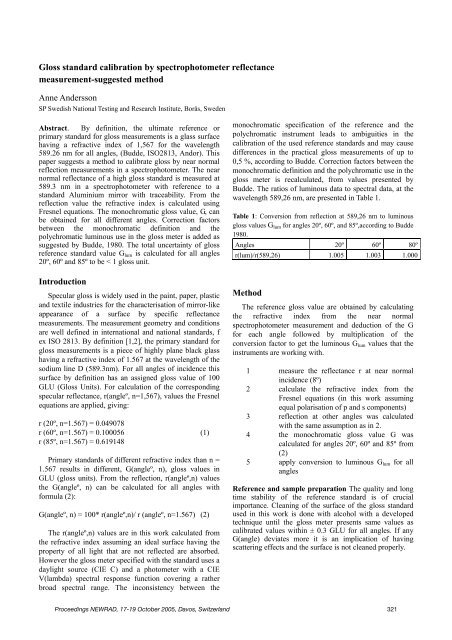Here - PMOD/WRC
Here - PMOD/WRC
Here - PMOD/WRC
You also want an ePaper? Increase the reach of your titles
YUMPU automatically turns print PDFs into web optimized ePapers that Google loves.
Gloss standard calibration by spectrophotometer reflectance<br />
measurement-suggested method<br />
Anne Andersson<br />
SP Swedish National Testing and Research Institute, Borås, Sweden<br />
Abstract. By definition, the ultimate reference or<br />
primary standard for gloss measurements is a glass surface<br />
having a refractive index of 1,567 for the wavelength<br />
589.26 nm for all angles, (Budde, ISO2813, Andor). This<br />
paper suggests a method to calibrate gloss by near normal<br />
reflection measurements in a spectrophotometer. The near<br />
normal reflectance of a high gloss standard is measured at<br />
589.3 nm in a spectrophotometer with reference to a<br />
standard Aluminium mirror with traceability. From the<br />
reflection value the refractive index is calculated using<br />
Fresnel equations. The monochromatic gloss value, G, can<br />
be obtained for all different angles. Correction factors<br />
between the monochromatic definition and the<br />
polychromatic luminous use in the gloss meter is added as<br />
suggested by Budde, 1980. The total uncertainty of gloss<br />
reference standard value G lum is calculated for all angles<br />
20º, 60º and 85º to be < 1 gloss unit.<br />
Introduction<br />
Specular gloss is widely used in the paint, paper, plastic<br />
and textile industries for the characterisation of mirror-like<br />
appearance of a surface by specific reflectance<br />
measurements. The measurement geometry and conditions<br />
are well defined in international and national standards, f<br />
ex ISO 2813. By definition [1,2], the primary standard for<br />
gloss measurements is a piece of highly plane black glass<br />
having a refractive index of 1.567 at the wavelength of the<br />
sodium line D (589.3nm). For all angles of incidence this<br />
surface by definition has an assigned gloss value of 100<br />
GLU (Gloss Units). For calculation of the corresponding<br />
specular reflectance, r(angleº, n=1,567), values the Fresnel<br />
equations are applied, giving:<br />
r (20º, n=1.567) = 0.049078<br />
r (60º, n=1.567) = 0.100056 (1)<br />
r (85º, n=1.567) = 0.619148<br />
Primary standards of different refractive index than n =<br />
1.567 results in different, G(angleº, n), gloss values in<br />
GLU (gloss units). From the reflection, r(angleº,n) values<br />
the G(angleº, n) can be calculated for all angles with<br />
formula (2):<br />
G(angleº, n) = 100* r(angleº,n)/ r (angleº, n=1.567) (2)<br />
The r(angleº,n) values are in this work calculated from<br />
the refractive index assuming an ideal surface having the<br />
property of all light that are not reflected are absorbed.<br />
However the gloss meter specified with the standard uses a<br />
daylight source (CIE C) and a photometer with a CIE<br />
V(lambda) spectral response function covering a rather<br />
broad spectral range. The inconsistency between the<br />
monochromatic specification of the reference and the<br />
polychromatic instrument leads to ambiguities in the<br />
calibration of the used reference standards and may cause<br />
differences in the practical gloss measurements of up to<br />
0,5 %, according to Budde. Correction factors between the<br />
monochromatic definition and the polychromatic use in the<br />
gloss meter is recalculated, from values presented by<br />
Budde. The ratios of luminous data to spectral data, at the<br />
wavelength 589,26 nm, are presented in Table 1.<br />
Table 1: Conversion from reflection at 589,26 nm to luminous<br />
gloss values G lum for angles 20º, 60º, and 85º,according to Budde<br />
1980.<br />
Angles 20º 60º 80º<br />
r(lum)/r(589,26) 1.005 1.003 1.000<br />
Method<br />
The reference gloss value are obtained by calculating<br />
the refractive index from the near normal<br />
spectrophotometer measurement and deduction of the G<br />
for each angle followed by multiplication of the<br />
conversion factor to get the luminous G lum values that the<br />
instruments are working with.<br />
1 measure the reflectance r at near normal<br />
incidence (8º)<br />
2 calculate the refractive index from the<br />
Fresnel equations (in this work assuming<br />
equal polarisation of p and s components)<br />
3 reflection at other angles was calculated<br />
with the same assumption as in 2.<br />
4 the monochromatic gloss value G was<br />
calculated for angles 20º, 60º and 85º from<br />
(2)<br />
5 apply conversion to luminous G lum for all<br />
angles<br />
Reference and sample preparation The quality and long<br />
time stability of the reference standard is of crucial<br />
importance. Cleaning of the surface of the gloss standard<br />
used in this work is done with alcohol with a developed<br />
technique until the gloss meter presents same values as<br />
calibrated values within ± 0.3 GLU for all angles. If any<br />
G(angle) deviates more it is an implication of having<br />
scattering effects and the surface is not cleaned properly.<br />
Proceedings NEWRAD, 17-19 October 2005, Davos, Switzerland 321
















